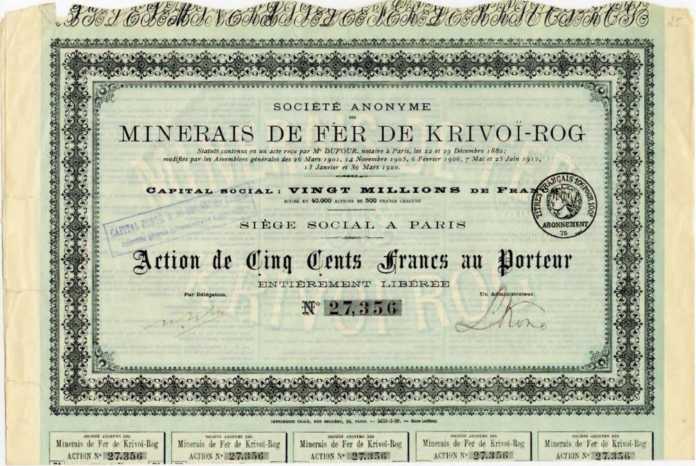In 1897, the Russian Empire was visited by the President of the French Republic, Felix Faure. It is unknown whether he visited Ukrainian lands, but he was informed about the rapid development of industry in the Kryvyi Rih-Donetsk region. Therefore, after returning to Paris, when the representatives of the trading world and the industrialists held a banquet for him, Faure, being impressed by what he had heard, said in his speech: “Without any loss of time, start to acquire new markets… hurry to send the barely familiar unexplored areas a private initiative … to promote the emigration of capital. We will not let foreign competitors be ahead of ourselves…”. He was heard. So, if by the calculations of the researchers in the 1870s, only 5 French joint stock companies were opened, in the 1880s – 9, then in the 1890s – 29, out of which 18 – in 1896-1900. This was the most significant period of the French investment in the industry of Ukraine.
At the end of the XIX century, the French investments became decisive in terms of beginning of the first industrialization of Ukraine (then Southern Russia).
It was France that offered its hand to Ukraine at the time when bureaucratic imperial structures had been refusing for 10 years financing of the work on the industrial development of high-quality iron ore in Kryvyi Rih region, the ore, which resolved destiny of the heavy industry development in Ukraine.
In December 1880, the Ukrainian landowner, who initiated and funded the exploration of the ore deposit, O. Pol found people in Paris, in particular, Pol Talabo, who took risks and set up Kryvyi Rih Iron Ore Joint Stock Company with a capital of 5 million francs. The company issued 10,000 shares of 500 francs that were taken within 24 hours! Among the shareholders were French entrepreneurs, bankers, engineers whose names were well-known and who knew their stuff. The case of industrial development of ore was moving fast, providing the first in Katerynoslav governorate factory of Englishman John Hughes (Hughesovka, a modern city of Donetsk, Donetsk metallurgical combine) the best ore for the production of railroads.
Kryvyi Rih Iron Ore Joint Stock Company was the second judging by the time of foundation by the French company in Ukraine. The first one was the French Mining and Industrial Society, known as the “Rutchenkivske Mining and Industrial Society” (1875), the third – the Society for the development of rock salt and natural soda in the South of Russia (1884). Thus, the first industrial joint-stock companies, created at the expense of French investment in the empire, acted precisely in the Ukrainian region.
It had been 20 years from the beginning of the 1880s, when the new mining region began to develop in Ukraine. And the region left far behind and overshadowed with its glory the other regions of the empire, Ural and Polish, in its development. Judging by the pace of growth of the Ukrainian industrial region, – “unheard success, the American image of the production development” – stated the researchers in the early XX century. And all thanks to the foreign investments in the region.
France was the main financial investor of the empire, but its interest was concentrated in the Kryvyi Rih – Prydniprovsk – Donetsk region, near the rich coal and iron ore deposits.
French banks, and in the first place the Societe Generale bank, which establishes and finances industrial giants, became the driving force of French capital at that time.
Indeed, the history tells that thanks to Franco-Belgian investments, entrepreneurship, drawings, know-how in south-eastern Ukraine (then Katerynoslav governorate), giant metallurgical plants with blast furnaces were built. And these were the largest and best plants in the empire, the images of which staggered the imagination of contemporaries.
French investors invested money in the construction of the Oleksandrivsk metallurgical plant and the pipe-rolling plant in Katerynoslav (now Dnipro City), the Dnipro plant in the village of Kamianske (Prydniprovsky industrial region). In 1914, the French capital functioned in 12 metallurgical joint stock companies of the region out of 14. Thus, most of the big metallurgical plants of the Katerynoslav governorate belonged entirely or partially to French capital. At the Paris Stock Exchange, shares of 10 companies of the metallurgical industry of Ukraine – Kryvyi Rih, Nikopol-Mariupol, Russian-Belgian, South-Russian Dnipro, Donetsk-Yurivka, Olkhovka, Russian Providans, Konstiantyniv, Donetsk and Briansk – rotated.
Metallurgical joint-stock companies had their mines, coal mines in Kryvorizhzhia and Donbass. French capital was also invested in construction and chemical enterprises, mechanical engineering and electricity, railway construction in the Dnipro region and Donbass.
The original materials of the museum’s stock are the evidence of this story – securities of joint stock companies, photographs of French and Ukrainian entrepreneurs, founders and managers of factories, metal mines and coalmines.
There are the autographs of well-known French entrepreneurs, bankers – Р. Duvall, P. Dumera (in the future – the President of France), E. Pasteur, M. Versstrat, T. Lombardo and many others on the shares and bonds. There is also an autograph of famous French banker and industrialist Pierre Darcy (1870-1918), who was called “a venerable metallurgist”. Accused of conspiracy against the Soviet power, arrested, he died on December 23, 1918, after three months of staying in Butyrka prison, because of cold, hunger and disease.
Geography of the enterprises with French capital is the most diverse. It includes Kryvyi Rih, Kamianske, Katerynoslav (now Dnipro), Luhansk, Yenakiieve, Mariupol, Debaltsevo, Toretsk, Nikopol, Druzhkivka, Makiivka, Krasnohorivka, Alchevsk, Shterivka and others. Many enterprises, created in the 1890s, have survived to this day.
Dmytro Pirkl, a co-author of the project “Foreign Investments in Ukraine. The end of XIX – the beginning XX century.” Valentyna Lazebnyk, the Head of the Department of the Dnipropetrovsk National History Museum named after D.I. Yavornytsky













